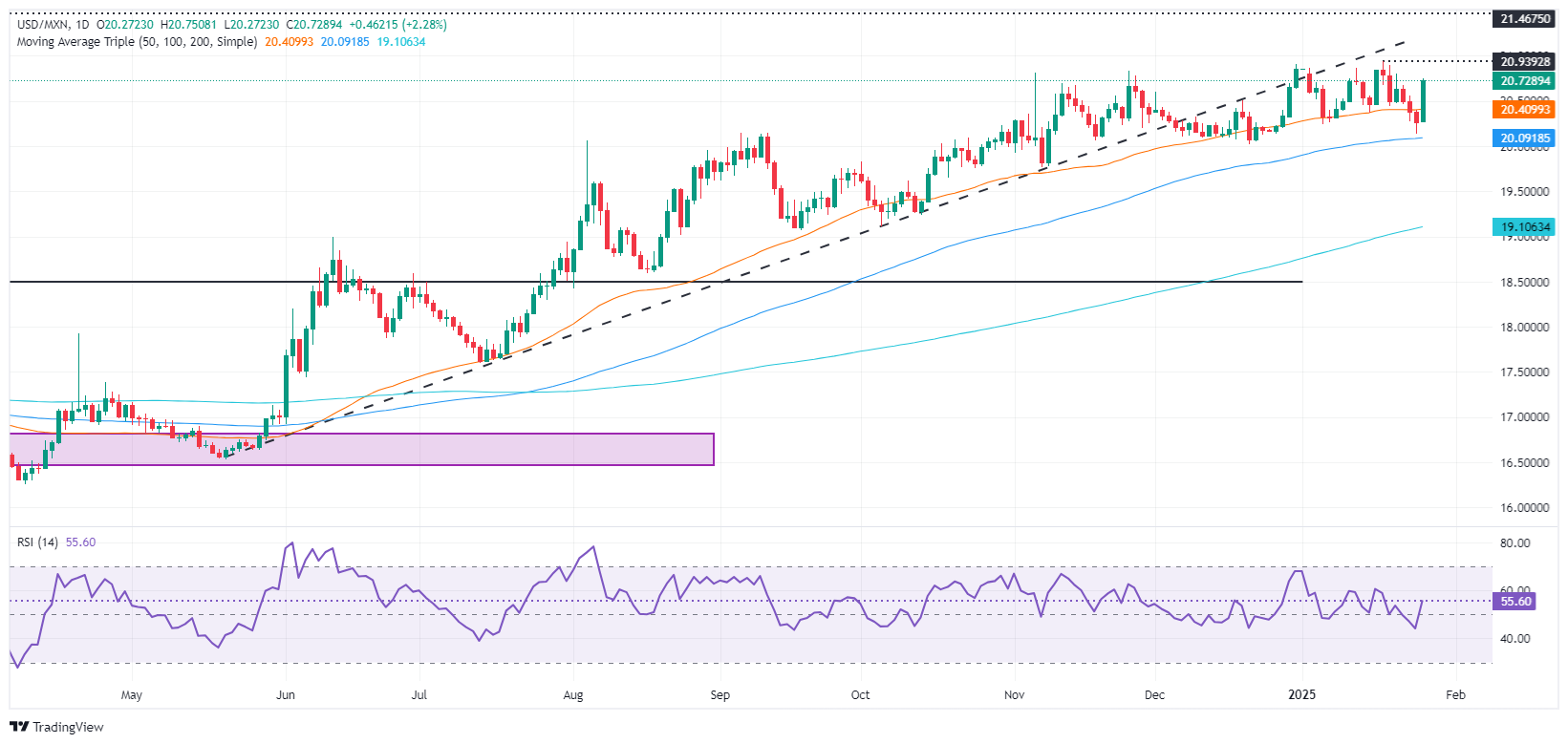- The Mexican peso under pressure after Trump’s threat of tariffs on Colombian goods.
- Banxico’s new monetary program suggests aggressive rate cuts, a headwind for the Peso.
- Traders await Mexico’s next economic reports on unemployment and preliminary GDP for the fourth quarter.
The Mexican peso plummeted against the dollar on Monday after US President Donald Trump announced on Sunday that he would impose tariffs on Colombian goods after Colombian President Gustavo Petro did not allow US planes ( USA) will transport migrants on deportation flights. Trump then backtracked on the tariffs Monday morning once the two leaders reached a deal to allow the deportations. This and the dovish rhetoric from the Bank of Mexico (Banxico) sponsored a boost in the exotic pair. USD/MXN is trading at 20.70, up more than 2%.
Over the weekend, US President Donald Trump reported Petro’s decision on his social network, prompting several retaliatory measures from the US, including the threat of tariffs. Consequently, the Mexican peso, used as a proxy for other Latin American currencies, weakened in early trading on Monday.
Meanwhile, the National Institute of Geography and Informatics Statistics (INEGI) revealed that the Trade Balance registered a surplus in December. However, seasonally adjusted, the deficit narrowed compared to November figures.
Meanwhile, Banxico presented its Monetary Program for 2025, in which the Central Bank hinted that the Governing Board is considering cuts to its main reference rate of a greater magnitude than previously seen in 2024.
The governor of Banxico, Victoria Rodríguez Ceja, said they see an adverse scenario with Trump, adding that some of his policies could put pressure on Mexico’s economy.
She added, “On the one hand, further economic weakness would tend to moderate price pressures and, on the other hand, further exchange rate depreciation represents an upside risk to inflation. These effects in opposite directions could even offset each other.” each other, but we would have to be attentive, if necessary, to the measures that could be implemented.”
This week, Mexico’s economic agenda will include the December Unemployment Rate, along with the publication of preliminary figures for the Gross Domestic Product (GDP) for the fourth quarter of 2024.
Daily Market Summary: Mexico’s Trade Balance Failed to Boost the Peso
- INEGI revealed that the Trade Balance for December was 2.567 billion, compared to a deficit of -0.133 billion. Seasonally adjusted, the trade deficit decreased from -0.775 billion to -0.684 billion for the same period.
- Economists polled by Reuters project GDP will fall -0.2% quarter-on-quarter from an expansion of 1.1%. On an annual basis, GDP is expected to decline from 1.6% to 1.2%.
- Citi revealed its Expectations Survey, in which Mexican private economists revised GDP figures for 2025 downward to 1%.
- As for inflation expectations, analysts estimate that headline and core inflation will drop below 4%, each at 3.91% and 3.68%, while the exchange rate will likely end up near 20.95.
- Economists estimate that the Bank of Mexico (Banxico) will reduce rates by 25 basis points (bp) from 10.00% to 9.75%, although some analysts expect a 50 bp cut at the February 6 meeting.
- Money market futures have priced in 54 bps of Fed rate cuts in 2025, according to data from the CME FedWatch tool.
USD/MXN Technical Outlook: Mexican Peso Steady as USD/MXN Nears Yearly High (YTD)
The USD/MXN pair resumed its uptrend after breaking above the 50-day SMA at 20.38 since early trading during the Asian session. Trump’s tariff threats on Colombia weakened the Mexican Peso amid a risk-off scenario, as the Peso fell to a four-day low of 20.74.
If traders break the USD/MXN all-time high of 20.90, buyers would be in charge and challenge the 21.00 mark. With further strength, the next resistance would be the March 8, 2022 peak at 21.46, ahead of the 22.00 figure.
On the contrary, if USD/MXN falls below the 50-day SMA of 20.38 and extends its losses towards the 100-day SMA at 20.06, the bears could aim to push prices towards the 20.00 mark.
Mexican peso FAQs
The Mexican Peso (MXN) is the most traded currency among its Latin American peers. Its value is largely determined by the performance of the Mexican economy, the policy of the country’s central bank, the amount of foreign investment in the country and even the levels of remittances sent by Mexicans living abroad, particularly in the United States. . Geopolitical trends can also affect the MXN: for example, the nearshoring process (or the decision by some companies to relocate manufacturing capacity and supply chains closer to their home countries) is also seen as a catalyst for the currency. Mexican, as the country is considered a key manufacturing center on the American continent. Another catalyst for the MXN is oil prices, as Mexico is a key exporter of the raw material.
The main objective of Mexico’s central bank, also known as Banxico, is to keep inflation at low and stable levels (at or near its target of 3%, the midpoint of a tolerance band between 2% and 4%. %). To do this, the bank establishes an appropriate level of interest rates. When inflation is too high, Banxico will try to control it by raising interest rates, which makes borrowing more expensive for households and businesses, thus cooling demand and the economy in general. Higher interest rates are generally positive for the Mexican Peso (MXN) as they lead to higher yields, making the country a more attractive place for investors. On the contrary, lower interest rates tend to weaken the MXN.
The publication of macroeconomic data is key to evaluating the state of the economy and can have an impact on the valuation of the Mexican peso (MXN). A strong Mexican economy, based on high economic growth, low unemployment and high confidence is good for the MXN. Not only does it attract more foreign investment, but it may encourage the Bank of Mexico (Banxico) to raise interest rates, particularly if this strength is accompanied by high inflation. However, if economic data is weak, the MXN is likely to depreciate.
As an emerging market currency, the Mexican Peso (MXN) tends to rise during periods of risk, or when investors perceive overall market risks to be low and are therefore eager to engage in investments that carry higher risk. . Conversely, the MXN tends to weaken in times of market turbulence or economic uncertainty, as investors tend to sell riskier assets and flee to more stable safe havens.
Source: Fx Street
I am Joshua Winder, a senior-level journalist and editor at World Stock Market. I specialize in covering news related to the stock market and economic trends. With more than 8 years of experience in this field, I have become an expert in financial reporting.








